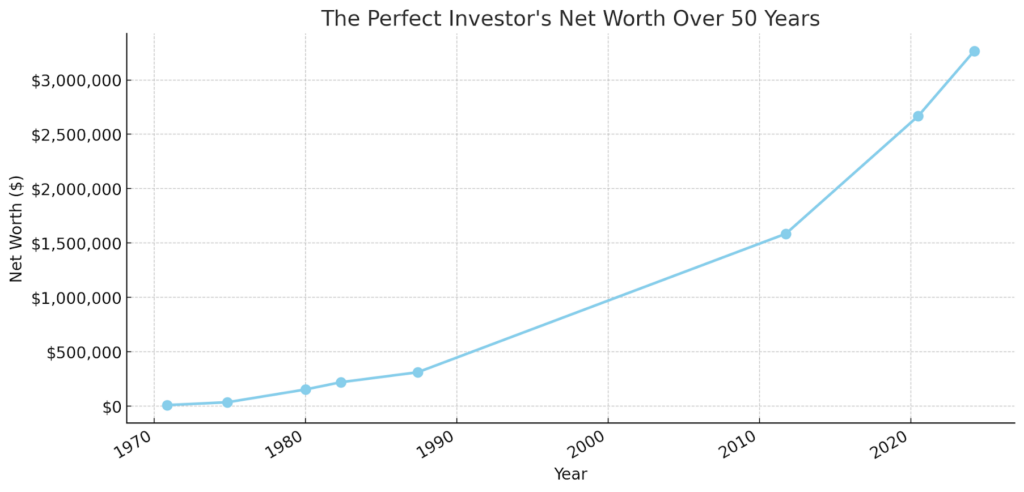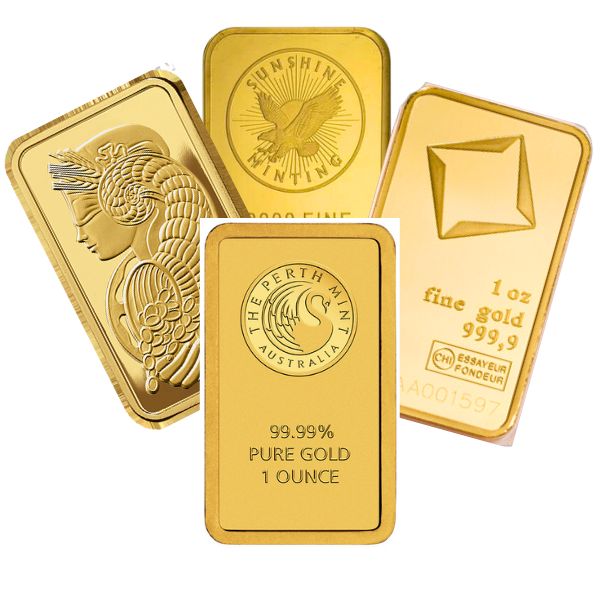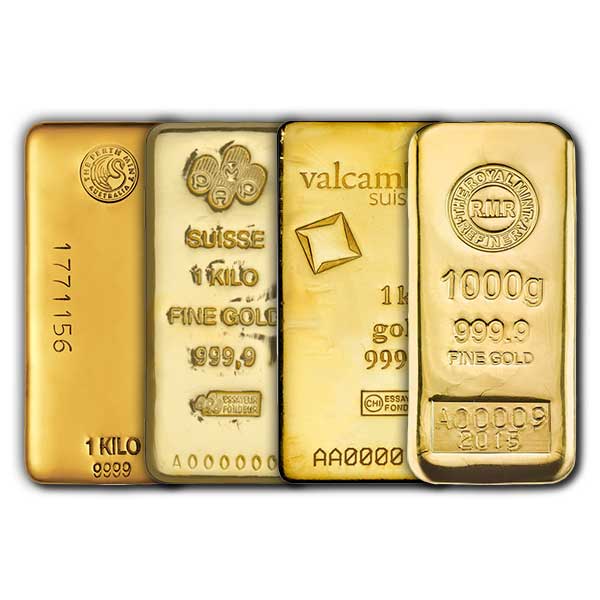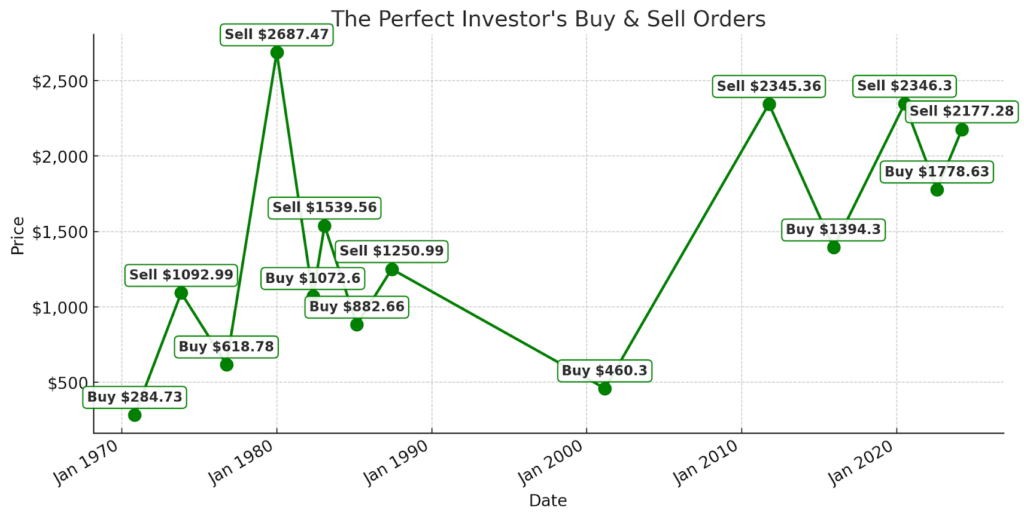The Perfect Gold Investor: A 50-Year Dive into Gold’s Peaks and Valleys

If an investor was perfect in their gold predictions since 1970, just how rich would they be today?
Just last week, gold hit a new all time high.
The precious metal is trading at a stunning $2,177.28 per troy ounce as of this morning — a promising sign for investors anticipating a good year for gold.
Historically, gold has won a reputation as the “safe” investment. To many old-school investors, gold’s price trends are steady and consistent, making it one of the world’s best safe haven assets.
But if the past couple of years have taught us anything, it’s that gold’s price action can sometimes be anything but slow and steady. Major peaks in valleys characterized the metal’s charts in 2023, and it looks like 2024 may be more of the same.
This got us thinking.
What would the perfect gold investor have done in the past five decades? If there was an investor who could use a crystal ball (or insider information) to accurately predict and respond to every single major gold price movement, how much money would they have made off of gold?
We’ll give you a hint — it’s a lot.

Keep reading – we’ll tell you exactly how the world’s best (hypothetical) investor turned $10,000 into over $3,000,000.
This is the story of the (hypothetical) perfect gold investor — and the millions they would have made playing the market since 1970.
Set-Up (The Boring Stuff)
To track the massive earnings of the divinely inspired (hypothetical) perfect gold investor, we’ll need to make some rules.
First, we’ll use inflation-adjusted gold prices. There are a couple of reasons for this. Unadjusted gold values can be misleading. Gold was worth just over $600 in January of 1980, which is around 1/3.6 of the metal’s current value. But if we adjust for inflation, January 1980 was actually gold’s true all time high, clocking in at just over $2,600/oz.
Adjusting for inflation initially is also just easier than trying to do it after we make our calculations. You can chalk this up to laziness, or you could consider it a gift that I’m sparing both of us from doing all that confusing math.
Second, our (hypothetical) perfect investor knows that they’re betting on the right gold price movement at any given time. Such an investor would invest 100% of their profits back into gold when prices fall, and sell 100% of their stockpile when prices peak.
Also, the (hypothetical) perfect investor would never bother with paying the premiums that we normal gold stackers have to contend with. For the purposes of this (hypothetical) case study, our ideal investor has worked his magic on gold dealers to secure all of his gold bullion at spot price.

One final thing: I’m going to be rounding throughout this process. Some of the numbers may be slightly off as a result of this rounding — but you’ll have to forgive a poor writer too tired to spend hours counting pennies!
Humble Beginnings — A Small Stack of 1 Kilo
We begin in November of 1970. Gold prices are low; the metal trades at a measly $284.73/oz.
Sipping tea in his office, the investor has an idea. Gold prices can’t possibly be so low, he thinks to himself. At once, he jumps up from his mahogany desk and sprints to the nearest gold exchange.
“Go big or go home,” he jokes to the gold dealer as he forks over his life savings: $9,154.27. The dealer looks at him strangely but places the cash in his till. He pulls out one massive gold bar weighing exactly 1 kilo and hands it to the mysterious investor, chuckling to himself as the foolish — but confident — investor skips out of his shop and exits into the muggy Boston street.
Normally, our investor would second-guess his decision. He’d panic about how much money he’d spent and, after talking things over with his wife, run back to the gold dealer and beg for his savings back.
But this investor just has a good feeling — he doesn’t return to the gold exchange. He places the large gold bar in his safe and sleeps like a baby as the moon hangs high in the sky.
Rising Prices and Steadfast Hands
As the price of gold rapidly begins to climb, the investor is hounded on all sides to sell.
International conflicts, oil crises, and uncontrolled inflation plagued the United States in the 1970s, causing investors to turn toward gold to protect their assets.
When gold hits $500, our investor’s wife asks him to sell. His friends join the fight. “Prices can’t stay this high for long,” his buddies tell him, imploring him to get out before the inevitable crash happens. But this investor knows something they don’t — and he holds fast, not even bothering to open his safe to check on the kilo gold bar it contains.
When prices hit $750, even his local gold seller tries to get him to sell. At this point, demand for gold is quickly approaching a record high. The dealer can’t keep up with demand and is desperate to get his hands on some stock to trade. Still, the (hypothetical) perfect gold investor knows that the best is yet to come.
Finally, the investor decides to sell. He’s held onto his kilo of gold for four years. In November 1974, gold prices hit $1,092.99/oz.
Carefully, he removes the gold bar from its safe and transports it to the local gold dealer. Again, the dealer considers the man a fool. Gold prices had climbed steadily since 1970 — clearly, they would only increase further in the coming years.
But who is he to deny a fool the fruits of his labor? The shopkeeper secures a loan with the bank and uses that money to buy 1 kilo of gold from the perfect investor.
Our favorite gold investor walks back to his house carrying $35,140.39 in cash.
Doubling (or Tripling) Down on Gold
Nearly two years later, the gold investor reads a newspaper. Gold prices have crashed. Investors are selling off their gold stacks in a mass panic, fearing that the metal will continue to fall.
It’s October of 1976, and gold is trading at $618.78 per troy ounce.
But this ideal gold investor doesn’t follow the crowd. He smiles to himself and grabs the hoard of cash from his safe. It’s once again time to make a deal with the local gold seller.
The gold salesman is happy to get rid of some of his bullion; the business has operated at a loss for quite some time, and the small silver lining of profit is enough to keep him from the brink of destitution.
Our investor walks out of the shop with 56.79 troy ounces of gold, and the dealer fills his till with $35,140.39.
The Best is Yet to Come
The story is much the same for the next four years. Everybody around him begs the gold investor to dump his stockpile as prices rapidly climb. But it’s like talking to a brick wall — the stubborn (hypothetical) gold stacker holds onto his 1.77 kilo custom gold bar for four more years.
In January of 1980, the gold market hits its absolute peak. Adjusted for inflation, this price spike constitutes the all time high for gold.
Gold is trading at an unbelievable $2,687.47 per ounce when the gold investor finally decides to make yet another trip to the poor local gold dealer. The dealer is desperate to keep building his own stock of gold bullion amid this unprecedented bull run, so he’s happy to buy back our hero’s 1.77 kilo bar.

The trader walks out with a cool $152,935.37 and no gold — for now!
Playing the Market
Over the next four decades, our brilliant trader continues to play the gold market. I don’t want to overload you with data, so let’s just run through the order of buy/sell orders that the (hypothetical) perfect gold investor would have made from 1980 until now.
In May of 1982, the investor buys 142.58 ounces of gold bullion. He sells it in February 1983 for a total of $219,516.30.
He’s not done yet. The investor takes that cash and buys 248.702 oz of gold bars when prices dip in March of 1985. He sells two years later in June 1987 for a grand total of $311,119.
Prices stay a bit too high for the perfect (hypothetical) gold investor over the next thirteen years. Finally, he jumps back into the marker when prices for the precious metal crash in March 2001. He walks out of his favorite pawn shop with 675.91 ounces of gold.
He holds for ten whole years until October of 2011. A combination of geopolitical conflicts cause gold to skyrocket to a mouth-watering $2,345 per troy ounce. This is where things start to get crazy. For readers keeping track, prices for gold in 2001 were just $460.30 per ounce.
The perfect gold investor spots that this is the height of gold’s price movement, so he decides to part with his 675.91 ounces.
Our (hypothetical) perfect gold investor pockets a cool $1,585,242 as he walks out of the old pawn shop.
Four years later in December 2015, he returns once again to the poor pawn shopkeeper. That’s right — this whole time, our (hypothetical) gold investor has been abusing this poor gold dealer, buying at the metal’s lowest low and then selling when it peaks.
He saunters into the joint and deposits his millions, walking out with a wheelbarrow full of 1,136.95 ounces of gold.
The shopkeeper knows by now that he hasn’t seen the last of the world’s best gold investor. But what could possibly make gold even more expensive than it is right now?

What the shopkeeper doesn’t know is that the gold dealer has one more big price swing to respond to. His crystal ball tells him that in 2020, something will happen to make gold one of the most lucrative investments on the planet.
The Grand Finale
In July of 2020, gold smashes records and hits a new all time high. On the heels of the COVID-19 pandemic, investors flocked to the precious metal for its safe haven properties. The influx of gold stackers caused gold to skyrocket in value.
For the perfect (hypothetical) gold investor, this is the perfect storm for one final price swing.
He sells his wheelbarrow full of gold for $2,667,614 in cash.
In August of 2022, gold crashes to $1,778.63 per ounce. Our investor responds by taking his wheelbarrow (now full of cash) to the same shopkeeper. The old man’s son is now running the joint, and he isn’t quite familiar with the tricks of the world’s most prolific gold investor. He happily processes the man’s order, giving our favorite investor 1,499.81 troy ounces of pure gold bullion for his money.
This brings our story to the present day.
Gold is at a new all time high, smashing its previous records as gold bulls anticipate lower interest rates and a slew of geopolitical stressors.
This morning, the precious metal is trading at $2,177.28 per troy ounce.
The (hypothetical) perfect gold investor makes one more visit to the pawn shop. He strolls past it, walking instead to the home of the original pawn broker. They’re both old men now, their faces weathered from nearly eighty years of well-lived lives.
“Well, my friend, let’s finish this how we started.”
The pawnshop owner smiles. The perfect gold investor has been a pain in his side for nearly five decades. But, like him, the investor seemed ready to retire, to ride off into the sunset with his millions and enjoy the fruits of his labor.
The two share a drink and laugh about their decades of trading. The pawn broker is sure his son will run the business right. “And,” he laughs to his old friend, “at least he won’t deal with you and your magical investing powers.”
Finally, the man opens his home safe. The investor walks out, carrying nine duffle bags full of cash.
He retires on top — with $3,265,506.31.
Wanna know when the perfect gold investor would have bought and sold over the past fifty years? Check out our graph below for all the details.

The Perfect Gold Investor — What’s Next?
Over the course of 50 years, the perfect gold investor would have spent $9,154.27 and ended his investment career with a cool $3.265 million.
Is it possible to be such a perfect investor. Obviously not. Still, investors who carefully watch the news and do their research and build a considerable nest egg for themselves by buying and selling gold bullion. If readers take a closer look at the buy/sell orders of the (hypothetical) perfect gold investor, they’ll notice that gold’s price correlates strongly with economic and geopolitical developments.
The story of the perfect gold investor ends with gold’s recent all time high – but our stories as imperfect but dedicated gold stackers are only beginning!
You might also be interested in:
About The Author
Michael Roets
Michael Roets is a writer and journalist for Hero Bullion. His work explores precious metals news, guides, and commentary.
